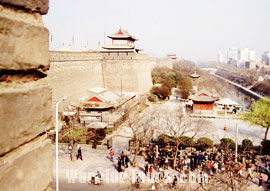- Big Wild Goose Pagoda & Tang Dynasty Palace
- Bell/Drum Tower & Daxingshan Temple
- City Wall
- Forest of Stone Steles Museum & Banpo Museum
- Great Mosque
- Huaqing Hot Springs & Xingjiao Temple
- Mausoleum of the First Qin Emperor
- Mausoleum of Western Han Emperor Liu Qi
- Terracotta Warriors
- Shaanxi History Museum
- Small Wild Goose Pagoda
- Famen Temple & Xianyang Museum
- Maoling Mausoleum & Tomb of Huo Qubing
- Mt. Huashan
- Qian Mausoleum & Zhaoling Mausoleum
City Wall

City Wall of Xian is an extension of the old Tang Dynasty structure, as a result of the wall-building campaign ordered by Zhu Yuanzhang, the first emperor of Ming Dynasty (from 1370 A.D.- 1375 A.D). After the enlargement, the city wall stands 12 meters (40 feet), 12-14 meters (40-46 feet) across the top, 15-18 meters (50-60 feet) thick at bottom and 13.7 kilometers (8.5 miles) in length with deep moats surrounding it. It boasts the most complete city wall to have survived through China's long history.
The wall was built of earth, rammed layer upon layer during the early time. The base layer was made of earth, quick lime, and glutinous rice extract, tempered together. This made the wall extremely strong and firm. Later, the wall was totally enclosed with bricks.
The Ming City wall encircles the city in a rectangle with one gate on each side. On the wall, fortifications such as watch towers, ramparts, (duo-kou) were built into a complex and well-organized system of defense.
There are total 98 ramparts on the wall and there are 120 meters distance from each other- towers that extruding out from the main wall. On the top of the rampart were 5984 2-metre- (7-foot-) high crenels called duo-kou. On the upper part of the duo-kou were large openings used to watch and shoot at attackers, and on the lower part were small openings, or loopholes, through which defenders could also shoot. The distance between ramparts is just within the range of arrow shot from either side, which allowed soldiers to protect the entire wall without exposing themselves to the enemy. Every several rampart on the wall has a sentry building of two or three stories where soldiers were stationed.

On the four corners of the wall were watchtowers. The one at the southwestern corner is round, probably after the imperial city wall of the Tang Dynasty, but the other three are square-shaped. On top of the watchtowers, the corner rampart, higher and larger than the ordinary ramparts, shows the strategic importance of corners of the city wall.
The existing Ming City Wall has 4 gates as: the South Yongning (Eternal Peace), the North Anyuan (Harmony Longevity), the West Anding (Harmony Peace) and the East Changle (Eternal Joy). Built outside each gate was a weng-cheng, a semicircular or polygonal parapet that shielded the gate from direct assault. Zhenglou is a triple-eaved building 34.6 meters (114 feet) long) where generals used to direct their soldiers. On the outer face were 48 openings from which missiles could be fired on a potential enemy. Zhalou was built opposite to the Zhenglou with the suspense bridge on the rear of the fort. The narrow tower - Jianlou where soldiers shoot arrows was connected with Zhenglou by weng-cheng. From weng-cheng, access ramps for horses lead to the top of the wall. There are all together 11 horse-passages around the city. The South Gate, to which visitors are usually taken, is well preserved. Today you will find souvenir shops and showrooms inside the gate structures. The West Gate has recently been opened to the public.
After several restorations, the longest unbroken section is from the Western Gate to the East Gate, a distance of approximately 5 kilometers (3 miles). Cycling on top of the wall in this section, you will have a bird's eye view of the city.
Cycling along the ancient City Wall would be a wonderful experience. A deposit of CNY 200 for the bike is required, and the rental is charged according to different types of bikes: taking a single bicycle costs CNY 40 for 100 minutes, a tandem bike for two costs CNY 60 for 100 minuess, and CNY 80/100 minutes for a tandem bike for three.
| Admission Fee: | CNY 40 |
| Opening Hours: | 08:00 to 19:00 (Spring and Summer) 08:30 to 17:00 (Fall and Winter) |
| Recommended Time for a Visit: |
Three hours |

